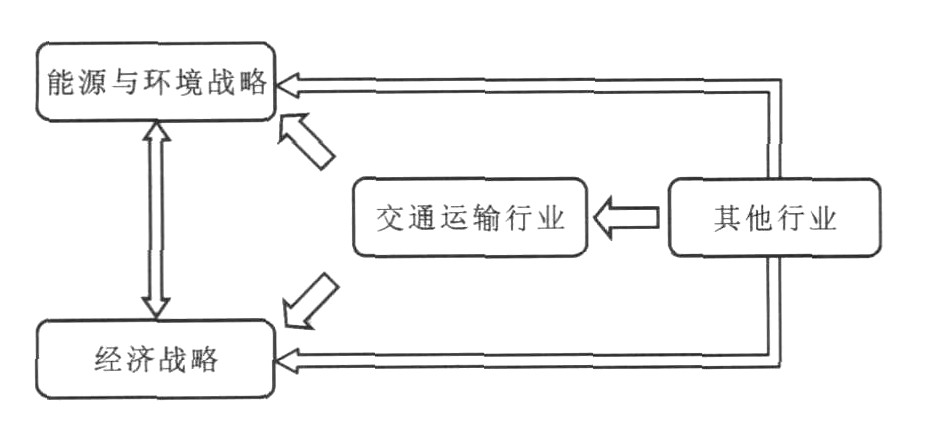Study of transportation and strategy of energy and environment in China
-
摘要: 为了指导交通运输行业节能减排工作, 分析了交通运输生产过程中能源消耗和环境影响特点, 论述了交通运输在中国能源和环境战略中的地位与在交通运输行业开展节能减排工作的意义, 提出了交通运输行业节能减排工作的目标和重点举措。研究结果表明: 加强交通运输行业节能减排工作, 既能为交通运输企业带来直接的财务效益, 也能为交通运输行业乃至整个国家带来巨大的直接和间接社会效益, 且关系到社会经济系统与生态系统的和谐发展, 因此, 需要从国家发展的战略层面加以重视。Abstract: In order to guide the energy saving and exhaust reducing in transportation, the characters of transportation energy consumption and environmental pollution were analyzed, the status of transportation in energy and environment strategy in China and the significance to carry out the energy saving and exhaust reducing in transportation were discussed, and the targets and key measures of the energy saving and exhaust reducing were pointed.Study result shows that strengthening the energy saving and exhaust reducing in transportation not only increases the direct financial benefit for transportation enterprises, but also brings a large amount of direct and indirect social benefit for transportation areas even for whole country, moreover accelerates the harmonious development between society and environment, so it should be recognized from the strategic angle of national continuance development.
-
Key words:
- transportation economy /
- energy /
- environment /
- strategy
-
表 1 能源生产与消费对比
Table 1. Comparison of energy production and consumption
年份 能源生产 能源消费 总量/109tce 煤炭比例/% 石油比例/% 天然气比例/% 总量/109tce 煤炭比例/% 石油比例/% 天然气比例/% 2001 13.7 71.8 17.0 2.9 14.3 66.7 22.9 2.6 2002 14.3 72.3 16.6 3.0 15.2 66.3 23.4 2.6 2003 16.4 75.1 14.8 2.8 17.5 68.4 22.2 2.6 2004 18.7 76.0 13.4 2.9 20.3 68.0 22.3 2.6 2005 20.6 76.4 12.6 3.3 22.3 68.9 21.0 2.9 2006 22.1 76.9 11.9 3.7 24.6 68.6 20.4 3.2 表 2 2005年能源消耗对比
Table 2. Comparison of energy consumption in 2005
行业能耗 能源消费/109tce 汽油消费/104tce 柴油消费/104tce 消费总量 22.3 4 853.3 10 972.5 交通运输、仓储和邮政业 1.7 2 470.1 5 019.4 化学原料及化学品制造业 2.2 22.1 97.7 黑色金属冶炼及延压工业 3.6 44.1 145.8 表 3 燃油消耗与节约情况
Table 3. Fuel consumption and saving conditions
年份 车辆数/veh 燃油消耗/104L 公司化经营后 汽油 柴油 合计 车辆数/veh 节约油耗/104L 2004 2 513 104.0 3 623.6 3 727.6 1 068 119.6 2005 2 812 64.3 5 812.2 5 876.6 1 253 254.3 2006 3 020 45.9 6 592.6 6 638.5 1 539 315.7 -
[1] SAIDUR R, SATTAR M A, MASJUKI H H, et al. Anestimation of the energy and exergy efficiencies for the energ yresources consumption in the transportation sector in Malaysia[J]. Energy Policy, 2007, 35: 4018-4026. doi: 10.1016/j.enpol.2007.02.008 [2] IFUE. Transport energy consumption and emissions in China[R]. Heidelberg: IFUE, 2007. [3] 吴文化. 我国交通运输行业能源消费和排放与典型国家的比较[J]. 中国能源, 2007, 29(10): 19-22. doi: 10.3969/j.issn.1003-2355.2007.10.004WU Wen-hua. The situation of energy consumption andemission of transportation sectors in China and comparison with typical countries[J]. Energy of China, 2007, 29(10): 19-22. (in Chinese) doi: 10.3969/j.issn.1003-2355.2007.10.004 [4] 闫海峰, 彭其渊. 铁路客货运输组织系统特性的比较分析[J]. 交通运输工程与信息学报, 2006, 4(3): 46-52. https://www.cnki.com.cn/Article/CJFDTOTAL-JTGC200603009.htmYAN Hai-feng, PENG Qi-yuan. Characteristic comparison between rail way passenger and freight transportation organizing systems[J]. Journal of Transportation Engineering and Information, 2006, 4(3): 46-52. (in Chinese) https://www.cnki.com.cn/Article/CJFDTOTAL-JTGC200603009.htm [5] 刘志峰. 交通运输节能二十年回顾(1980-1999)[J]. 船舶节能, 2000(3): 4-7. https://www.cnki.com.cn/Article/CJFDTOTAL-CBJL200003001.htmLI U Zhi-feng. Reviewfor 20 years about transportation energysaving(1980-1999)[J]. Shipping Energy Saving, 2000(3): 4-7. (in Chinese) https://www.cnki.com.cn/Article/CJFDTOTAL-CBJL200003001.htm [6] 吴群琪, 张圣忠. 运输供给的品质特性[J]. 长安大学学报: 社会科学版, 2006, 8(1): 1-4. https://www.cnki.com.cn/Article/CJFDTOTAL-XBJZ200601000.htmWU Qun-qi, ZHANG Sheng-zhong. Quality characteristics of transportation supply[J]. Journal of Chang an University: Social Science Edition, 2006, 8(1): 1-4. (in Chinese) https://www.cnki.com.cn/Article/CJFDTOTAL-XBJZ200601000.htm [7] 陈清泰. 实施节约优先的国家能源战略[J]. 中国流通经济, 2007, 21(6): 4-6. https://www.cnki.com.cn/Article/CJFDTOTAL-ZGLT200706001.htmCHEN Qing-tai. Implement the national energy strategy of "giving priority to conservation"[J]. China Business and Market, 2007, 21(6): 4-6. (in Chinese) https://www.cnki.com.cn/Article/CJFDTOTAL-ZGLT200706001.htm [8] 杨洪年. 我国交通运输业能源节约的战略选择[J]. 综合运输, 2006, 28(8): 17-19. https://www.cnki.com.cn/Article/CJFDTOTAL-YSZH2006Z1004.htmYANG Hong-nian. Strategy choice of transportation energy saving in China[J]. Comprehensive Transportation, 2006, 28(8): 17-19. (in Chinese) https://www.cnki.com.cn/Article/CJFDTOTAL-YSZH2006Z1004.htm [9] ZHOU Wei, SZYLIOWICZ J S. Energy, Environment and Transportation in China[M]. Beijing: China Communications Press, 2005. [10] 马银波, 郭明雅, 李晓明. 道路货运市场结构与技术进步关系的实证分析[J]. 长安大学学报: 自然科学版, 2006, 26(6): 81-85. https://www.cnki.com.cn/Article/CJFDTOTAL-XAGL200606018.htmMA Yin-bo, GUO Ming-ya, LI Xiao-ming. Emprirical analysis on relation of road freight market structure with technology progress[J]. Journal of Chang an University: Natural Science Edition, 2006, 26(6): 81-85. (in Chinese) https://www.cnki.com.cn/Article/CJFDTOTAL-XAGL200606018.htm -





 下载:
下载:


